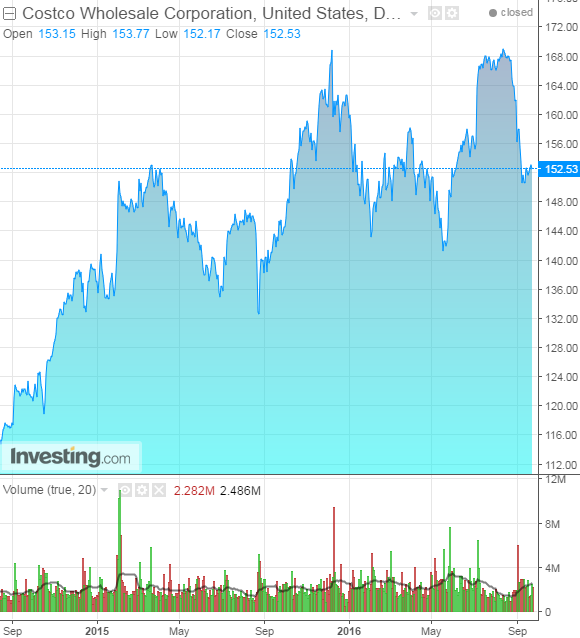by Clement Thibault
Costco (NASDAQ:COST), operator of wholesale membership warehouses, reports Q4 '16 earnings on Thursday, September 29, after the market closes.

1. Earnings and Revenue
Costco is expected to report earnings of $1.73 per share, along with $37.45 billion in revenue. Compared to last year's Q4 for Costco's fiscal year, meeting expectations will result in a 1.1% decline in EPS from $1.75, 4.6% growth in revenue. With $118 billion in annual revenue, Costco is the third largest retailer, by revenue, in the world, behind Walmart's (NYSE:WMT) massive $483 billion, and just lagging Amazon's (NASDAQ:AMZN) $120 billion.
2. Membership Fees
Memberships are one of the key pillars of Costco's business model. Indeed, paid up membership is the only way a consumer can gain access to any of Costco's 493 locations in the U.S, 90 warehouses in Canada, and a few others in the UK, Mexico and Japan. For $55 dollars a year any household can purchase a membership (for $110 annually businesses as well as one associated household can join). Customers are effectively purchasing the right to buy in bulk at Costco.
Over the past three quarters—since the beginning of Costco's fiscal 2016—membership fees accounted for just 2.2% of revenues, coming in at $1.8 billion compared to $80.3 billion of actual product sales. Still, a Costco without members is a Costco without customers, so the membership fees continue to be important. The number of members grew in the past year to 46.9 million, up 3.2 million from the same time last year.
As far as customer loyalty, Costco has a remarkable 90% renewal rate in the US and Canada, and an equally strong 88% internationally. Last year, renewal rates stood at 91% and 88%, so overall, numbers are consistent—and customer loyalty outstanding.
3. Comparable Sales
For a company like Costco, sales growth is the most important indicator of general health and the true barometer of growth. In particular, one should look at comparable sales, a metric which compares sales from the previous period, but only for warehouses that existed last year at the same time, while disregarding expansions. Thus, comparable sales are increased either by improving shopping frequency or by increasing the average amount spent.
During the past nine months, comparable sales at Costco have been flat. Within the US, which represents about 75% of Costco's revenue, comparable sales grew by 2%, but was offset by the Canadian and International segments, which lost 5% and 4% respectively during the period.
4. Gasoline
Gasoline sales had an adverse effect on comparable sales over the past three quarters. Excluding gasoline, the US segment would have grown by 4%, instead of 2%. Last quarter, Costco reported a 19% decrease in the average sales price per gallon, which is estimated to have impacted the company's sales by about $500 million dollars. Costco is reportedly not focused on short-term performance, and instead strives to provide the most competitive value. In the longer term this should prove to be the right call, as the attractiveness of Costco's gas prices drives membership numbers, which in turn brings more customers to Costco's warehouses.
Conclusion
Costco is a solid, well run retailer with an established and recognized brand. One of the best things about it is the way it does business—bulk packages at attractive prices based on memberships. Which means it's not in direct competition with online retailers nor with bricks-and-mortar chains.
For the foreseeable future—or at least until Amazon decides to grab a piece of this pie as well—Costco has a huge advantage over retailers such as Walmart and Macy's (NYSE:M). Though that's good news for investors who already own the stock, if you're looking for an entry point, that fact is already reflected in Costco's valuation.Their 28.5 P/E ratio strongly eclipses Walmart's 15.5 P/E or Macy's 14 P/E.
While Costco is clearly a good company and is expected to continue to provide low single-digit growth in the future, the upside is mostly priced in at this point. At about $150 a share, current levels aren't attractive enough. We suggest buying any dips of 10-15%, should they occur.
